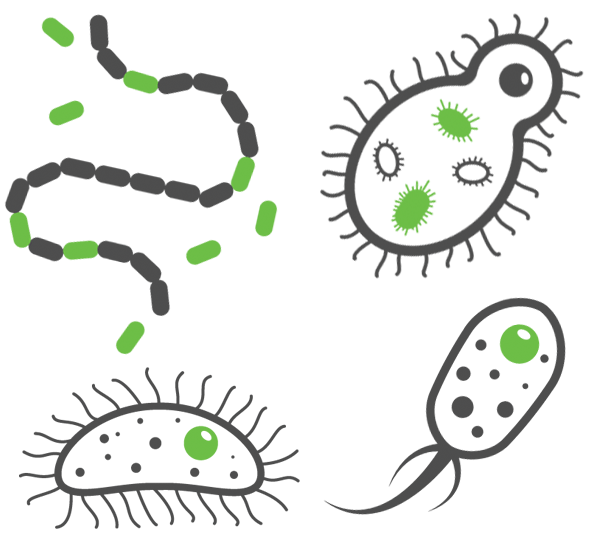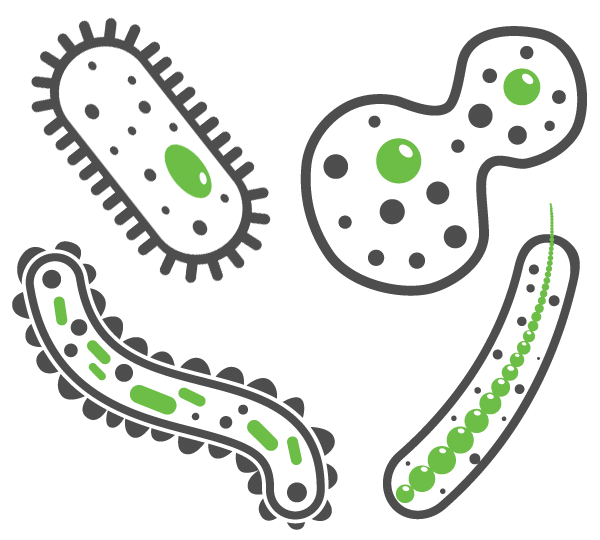Common bacterial infections
At many points in your life, you will suffer with common bacterial infections. It’s important you know how to recognise them and take steps to protect yourself from getting ill. There are a huge number of disease-causing bacteria that affect people, but some are much more common than others. Below, we’ve put together some detail about the most common bacterial infections you might experience.
This is not an exhaustive list and the described treatments are for general information and should not be considered medical advice. If you believe you have an illness or injury, please consult the NHS website, call 111 or visit your GP or hospital.
Urinary tract infection (UTI) or cystitis
Prevention
There are some simple steps you can take to help you avoid getting a UTI:
- Drink plenty of water
- Don’t try to ‘hold it in’ when you need to urinate
- Urinate after sexual intercourse
- Maintain good hygiene (washing and changing clothes regularly)
- Wipe from front to back when using the toilet
Treatment for UTIs
Although very unpleasant, the symptoms often go away with increased consumption of water. If they do not, visit your GP who may prescribe antibiotics. Research suggests that ‘delayed prescriptions’ (given at the time of diagnosis for collection from the pharmacy up to seven days ahead) may reduce the use of antibiotics, in turn helping to prevent antibiotic resistance. Allowing a UTI to go untreated can mean it spreads further up the urinary tract, eventually reaching the kidneys.
First line treatment for UTIs is the antibiotic nitrofurantoin which is taken orally as tablets. If this doesn’t eliminate the infection, other antibiotics such as fosfomycin and pivmecillinam might be used. In order to find an effective treatment, a urine sample may be taken to allow clinicians to grow a sample of the bacteria in the lab. They can then apply different antibiotic treatments to this sample to see which is most effective, before prescribing the best option to the patient. According to Public Health England, more than one million UTI patient samples required further investigation in 2016, a considerable economic cost to the country.
UTIs are common among women, and less frequently affect men too. Women are more prone to UTIs owing to have a shorter urethra than men. This makes it easier for bacteria to reach the bladder. UTIs are caused by bacteria (usually Escherichia coli) entering the urinary tract and multiplying there. They can affect your urethra (lower UTI, or cystitis), or in more serious cases your bladder or kidneys.
The main symptoms are pain during urination, an increased need to urinate and blood in your urine. The urine may also be cloudy and/or smelly. You may also have pain in your tummy and feel more tired than usual. Although very unpleasant, these symptoms often go away with increased consumption of water. If they do not, visit your GP who may prescribe antibiotics.
Children and babies with a UTI may wet themselves or their bed, or alternatively deliberately hold in their need to urinate to avoid the pain. They may also appear generally unwell, with a fever and refusal to feed.
The overuse of antibiotics, and people taking antibiotics that aren’t effective against their particular infection, both contribute to antibiotic resistance. The pain caused by UTIs can be very intense, but it is important to listen to your GP. They may recommend running tests that take a little time in order to choose the right antibiotic for you.
UTIs are harder to diagnose in patients with dementia as they can be unable to communicate about their symptoms. There is growing evidence that UTIs are more prevalent in this population than originally thought.
If you think you have a UTI and have not yet sought treatment, find out what the NHS recommends. You can also visit our page about antibiotic resistant UTIs to learn more.

You can help change the world
In countries with less strict rules about antibiotic use, as many as 50% of the women reporting UTI infection have had to be treated with IV antibiotics. Some of those women will lose their lives to kidney failure and more immediately sepsis, either as a result of the infection or the toxicity of the antibiotics. Even in countries with strict regulations, like the UK, resistant bacteria are arriving and arising all the time.
Please make a donation to support our research. We aim to fund the development of new antibiotic treatments and research into alternative therapies. Every single one of our children and grandchildren are at risk. Let’s fight for a future where simple infections no longer cost lives.

Skin infections
Serious skin and deep tissue infections are caused by bacteria getting into the body through broken skin. It could be broken due to an injury – a cut, insect bite, puncture wound – or through other openings, such as piercing holes, surgical wounds or medical equipment entry points.
People with diabetes (Type 1 or Type 2) can suffer from foot ulcers that can become infected. If you are a diabetic then essential foot hygiene can help ward off the possibility of the foot becoming gangrenous. The bacteria that causes these infections lives on the skin of all healthy people. Proper hygiene is important at all times, even if you do not have any current wounds. If you do have wounds, however, it is especially vital that you keep them clean. There are a great many types of bacterial infection that can affect the skin, most of which can be easily treated with antibiotics.
Antibiotics only work against bacterial infections. This page does not cover conditions such as ringworm or athlete’s foot (fungal), cold sores (viral) or scabies (parasitic), although these conditions can allow bacterial infections to take hold, too. For more information, visit the NHS page about common skin conditions.
Common bacterial infections of the skin and deep tissue, which are often caused by Staphylococcus or Streptococcus, include:
- Impetigo, which affects the top layer of skin (the epidermis). It is more common in children than adults and is highly contagious.
- Cellulitis, which affects deeper layers of skin and tissue (the dermis and subcutaneous tissue), and often occurs in ulcers or surgical wounds. If it is not treated quickly and effectively it can rapidly spread to other parts of the body and cause life-threatening conditions such as sepsis.
- Methicillin-resistant Staphylococcus aureus (MRSA), a superbug that often starts as a small sore on the skin. If left untreated, the infection can quickly spread to the rest of the body through the bloodstream. It is easily spread and resistant to penicillin-type antibiotics.
Other less common skin/tissue infections include the following conditions:
- Erysipelas, which affects the top two layers of skin
- Necrotising fasciitis, often called a ‘flesh-eating’ bacterial infection
- Bacterial folliculitis, an infection of the hair follicle, or furuncles, which are an infection of an entire hair-growth unit, and carbuncles, which are groups of furuncles
- ‘Hot tub’ folliculitis caused by Pseudomonas aeruginosa, which is commonly found in water
- Erythrasma – which occurs where skin touches skin. It looks like athletes foot so is often misdiagnosed and treated with antifungals, which are not effective against bacterial infections.
Causes & Prevention
If you have a small injury that does not require medical assistance, wash it with soapy water, or use alcohol wipes, regularly. Keep it covered if you are likely to be exposed to dirt, such as when working outside or playing with pets. Otherwise, keep the wound dry and exposed to fresh air to help it heal effectively.
For other types of injury that do require medical attention, follow the advice of the clinician that treats you. This may include visiting a nurse for regular dressing changes, regularly cleaning the area with salt water or an antiseptic rinse, or taking antibiotics.
Symptoms
The first symptoms of common bacterial infections in the skin are usually swelling, redness and heat in the affected area. This is often accompanied by pain, and pus or ‘weeping’ from the wound as the body tries to fight the infection. If you believe you have an infected wound you should go to your GP to see if it needs to be treated.
If an infection is left untreated the symptoms above may worsen, and more serious symptoms may arise.
Treatment
Treatment for skin infections varies depending on the type and severity of the infection, as well as the part of the body it affects. If possible, swabs will be taken prior to treatment in order for the clinician to choose the most effective antibiotic for the infection, rather than using a trial-and-error approach, which can lead to resistance and is not beneficial to the patient.
Staphylococcal infection of the epidermis (mild impetigo) may be treated with a topical cream. For severe, long-term or resistant impetigo, a different type of cream (or nasal spray to eradicate MRSA prior to surgery) is used. Topical antiseptics may be used in conjunction, particularly if there is a build-up of dried pus on the area requiring cream. Some infections in small wounds may be treated using oral antibiotic tablets.
Deep infections, such as infections in the legs or around wounds – which are often cellulitis – require ‘systemic’ treatment, or intravenous (IV) antibiotics delivered via a drip.

Respiratory infections
Respiratory tract infections (RTIs) can affect the sinuses, throat, airways or lungs. They can be caused by viruses or bacteria.
Viral respiratory infections (coughs and colds)
Most of us will experience viral respiratory infections (coughs, colds and mild chest infections), which go away without treatment. Antibiotics are not effective against viral infections. Many such infections take up to three weeks to clear; it is only after this time (or if the patient is very young, old or in poor health) that it would warrant a visit to a GP. Find out more on the NHS page about respiratory infections.
Pneumonia can be caused by a viral infection, aspiration of a harmful substance or foreign object, fungal infection (rare) or due to the use of a ventilator when in hospital. These types of pneumonia do not respond to antibiotics.
Bacterial respiratory infections (and pneumonia)
Pneumonia is swelling of the tissue in the lungs, usually caused by infection with bacteria. The most common cause is a pneumococcal infection with Streptococcus pneumoniae, although Staphylococcus aureus and Haemophilus influenzae can also cause it.
Symptoms
The symptoms of bacterial pneumonia can arise very quickly over the course of 24 hours, or take a period of days to develop. The symptoms include a cough (with thick mucus sometimes containing blood), breathlessness, rapid heartbeat, fever, sweating and shivering, loss of appetite and chest pain that worsens with breathing and coughing. In elderly people in particular, it can cause confusion and disorientation.
If a patient has severe pneumonia, is already unwell or weak, is very young or old, or does not receive prompt treatment, serious complications can arise. These include: pleurisy, lung abscesses or septicaemia (which can lead to sepsis).
Prevention
There is not much you can do to avoid getting a respiratory infection apart from avoiding people who are unwell themselves, maintaining good hygiene and eating a balanced diet. If you have pneumonia you are not usually advised to stay away from healthy adults while you recover. However, you should ensure you wash your hands regularly, and dispose of any tissues immediately. Smoking is also a significant risk factor for pneumonia.
Treatment
Diagnosis can be difficult due to pneumonia sharing symptoms with many other conditions. A GP will ask about symptoms and perform a chest examination, listening for crackling or rattling. If mild pneumonia is suspected, patients will be given antibiotics and advised to stay home and rest, drinking plenty of water. If more serious pneumonia is a risk, chest x-rays, blood tests and sputum samples may be required. Sometimes two types of antibiotic are given if the initial treatment does not work. If the symptoms are severe or do not go away without treatment, hospitalisation in order to give IV antibiotics, fluids and oxygen may be required. The NHS also provides additional information on treating pneumonia.

Sexually transmitted infections (STIs)
Many sexually transmitted infections are caused by bacteria. This does not include HIV or herpes (which are viral), or thrush (which is fungal). Some of the most common bacterial sexually transmitted infections are:
- Chlamydia (caused by Chlamydia trachomatis) affects the penis, vagina, cervix, anus, urethra, eye or throat.
- Gonorrhea (caused by Neisseria gonorrhoeae) affects the cervix, uterus, fallopian tubes, rectum, urethra, mouth, throat, penis or testicles.
- Mycoplasma genitalium affects the urethra, cervix, throat and anus.
- Syphilis (caused by Treponema pallidum) affects the mouth, penis, anus or vagina.
- Bacterial vaginosis and pelvic inflammatory disease are most often caused by the bacteria responsible for chlamydia and gonorrhea.
Causes & Prevention
Sexually transmitted bacterial infections are caused by sexual contact with a partner who has the infection. Many STIs are very hard to detect, presenting no symptoms at all, so the only way to be sure you do not have one is through clinical testing. It is best to get tested every year and in between new sexual partners. Here are some simple steps to avoid getting an STD; however, there is always a risk when engaging in sexual contact, and these measures only reduce the risk rather than removing it completely.
- Use condoms (non-spermicidal and unflavoured) and dams for penetrative sex and oral
- Use water- or silicon-based lubrication that do not contain sugar, not lotions or vaseline
- Maintain good personal hygiene
Symptoms
Some STDs do not cause any symptoms, but can still cause health problems and infertility if left untreated. Most STDs do not cause long-term damage if caught quickly and treated effectively. Some symptoms to look out for include:
- abdominal pain
- bleeding between periods
- fever sores
- painful intercourse
- painful urination
- pus-like discharge
- swelling or tenderness of the vulva
- anal itching
- painful bowel movements
Treatment
For more information about STIs, visit The STD Project, an American website with detailed information about these infections. Bear in mind that some information regarding treatment, such as drug names, medical costs and choice of treatment, may differ to the UK. If you or a loved one has an antibiotic-resistant bacterial STI, you can find out more on our AR STI page.

Non-bacterial infections
The following conditions are caused by viruses or fungi, so antibiotics are not effective treatments:
- Most coughs and colds
- Thrush
- Athletes’ foot
- Flu
